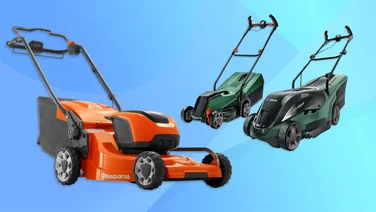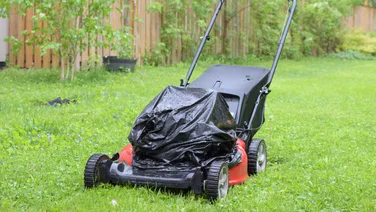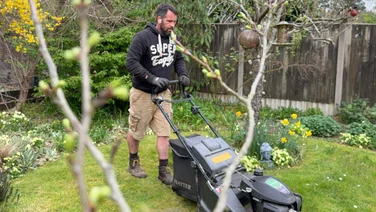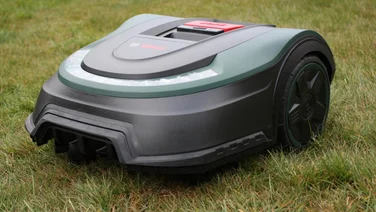To help us provide you with free impartial advice, we may earn a commission if you buy through links on our site. Learn more

Are you wondering how to improve a poor-quality lawn? Whether you’ve just moved into a house with a garden or you’ve simply neglected your grass for a while, reviving your patch of green needn’t be a daunting task. Making sure you’ve got one of the best cordless lawn mowers will certainly help you on your quest to tart your grass up.
With a few basic tools, a little patience, and some top tips from our experts, you’ll be able to liven up your lawn without any hassle. Follow our guide, and you’ll be enjoying lush green grass this summer and beyond.
New grass is best sowed in the spring, from mid-March onwards, or in the autumn, around September. Read on to discover how to improve your grass, starting with mowing and preparing the ground before reseeding and regrowing your lawn.
Mow your lawn
Grass grows in temperatures above 7ºC, so once the weather begins to warm, it might be time to dust off the lawn mower. But there’s no need to hack it down in one go: “Instead of going for that dramatic, all-at-once chop, think about a trim-and-tend approach”, suggests Cheryl Harper, managing director of Greensleeves Lawn Care. “Start with shorter, more frequent cuts to ease your lawn back into its prime.”“Cutting your lawn regularly to the correct height will encourage healthier growth from root to tip”, says Harper. So aim to only take off a third of the length at a time – to avoid losing the nutrients in each blade of grass – and go over the lawn more than once, moving in different directions to make sure all the grass gets cut.
“Mowing wet grass is never a good idea, since it can damage your lawn and clog your mower’s blades”, Harper adds. “If it has rained recently, or the grass is wet from the morning dew, wait until it dries out before you start mowing.”
For more in-depth tips on mowing the lawn, from choosing the right lawn mower to getting those perfect stripes in the grass, check out our guide to mowing a lawn.
Leave the grass cuttings
Don’t worry about picking up the grass cuttings: they give your garden a free hit of nutrient-rich mulch.
“Ideally, if you mow often enough then the clippings can be left to fall back to feed the lawn”, advises Guy Barter, chief horticultural advisor of the Royal Horticultural Society.
READ NEXT: Best robot lawn mower
Neaten the edges
If there’s one job you can do that will instantly make your lawn look better, it’s using a lawn edger or grass trimmer to get the edges neat and straight: “All lawns look better if neatly edged”, Barter says, “even if the grass is temporarily on the taller side.”
Aerate the soil
If some parts of your lawn aren’t growing or draining as well as you’d like, get stuck in with a garden fork and try to aerate the soil. “Think of aeration as your lawn’s ability to breathe”, says Cheryl Harper. “Punching little holes in the turf breaks up compacted soil that blocks air, water and nutrients, making sure your grass gets all the good stuff it needs from below the surface.”
Aerating is best done in spring or autumn, when the ground is soft. Moving across the lawn, stop every 15cm or so and push the fork 5-15cm into the ground. Make sure to wiggle the fork around, levering the soil up slightly so that water and oxygen can get in. If that sounds difficult, you could use a rolling lawn aerator, or strap on some lawn aerator sandals to spike holes in the turf.
“This isn’t just a one-off treat”, says Harper. “Making aeration a regular part of your lawn-care routine is key to maintaining its health and vibrancy.”

Scarify the moss
Scarification simply means removing dead grass, moss and thatch, which can prevent oxygen and water from getting to your lawn’s roots. “Aesthetically, moss can diminish your lawn’s charm, but the real concern runs deeper”, says Cheryl Harper. “If moss growth remains uncurbed, it gradually syphons vital nutrients away from your grass.”
Use a spring-tined lawn rake to gently scrape moss and thatch out by hand. Alternatively, for bigger gardens, you could opt for an electric scarifier – you push these along like a lawnmower, with a similar choice between cordless or corded models. Again, the best time to use a scarifier is in spring.
Scarifying the lawn may make it look a bit rough, but it will soon bounce back. For more advice, read our full guide on how to get rid of moss and mushrooms.
READ NEXT: Best leaf blower
Leave the weeds
Instead of worrying about weeds and unwanted plants, embrace the benefits of a diverse mix of plants in your garden. “There is much to be said for a certain level of weeds to support garden wildlife”, says RHS expert Guy Barter, “so, if possible, avoid being too harsh on weeds.”
He also suggests raking dwarf clover seed into the lawn, as clover converts, or “fixes”, nitrogen into a nutrient for your lawn. “If you already have some clover, cherish it”, says Barber. “Turf experts might turn up their noses at clover, but for everyday lawns, it brings savings in fertiliser costs and wildlife benefits.”
Weed the wildflowers
If you want a more manicured look, you’ll need to spend time weeding. Aerating and scarifying are still a good first step because they toughen up your grass so it can stand up to weeds. Then employ a hand trowel, fork or special weeding tool to banish weeds such as dandelions and daisies. Ideally, you’ll need to dig them out with the root to stop them coming back.

If you are considering using weed killers be careful not to use them in areas where grass is new.
When to feed a lawn
Mid-spring is a good time to feed the lawn. “March is ideal in most regions, preferably just before rain is forecast; but April is good enough”, says Guy Barter. You want to feed the lawn while it’s actively growing, using a fertiliser that’s high in nitrogen to encourage growth.
Check the forecast and try to apply the fertiliser when it’s likely to rain, or follow it up with some light watering, and don’t tread on areas you’ve treated with fertiliser and plant food. You’re less likely to be using your garden in spring anyway, while the days are shorter and the temperatures are still low.
Leave it for a couple of months and apply more fertiliser if things haven’t perked up, but don’t feed the lawn past August.
Make sure to keep your grass watered
If the weather turns out to be warm and dry, or if you’re laying new seed, you will likely need to water the lawn. You could spray a light mist from a hosepipe or sprinkler, but it’s more ecologically friendly (and cheaper) to collect and store rainwater for your garden, so you might think about investing in a water butt.
To get through particularly dry spells, you could also use “greywater” – the wastewater from the bath, shower or kitchen – though be aware that it may contain soap or detergents, so it’s best not to use greywater exclusively. And avoid using greywater that’s been used with bleach, or anything with chlorine.

READ NEXT: Best garden hose
Sow the seed
Reseed any bare patches a few days after feeding. Simply stir up the soil and throw some seeds across the area, then sprinkle on some potting compost. Birds love pecking up fresh seeds, so you might consider covering the area with netting to keep them off.
You can walk on recently sewn patches to firm in the roots, or run a roller over them, but don’t mow new grass until it has grown a few centimetres. Water well, and use diluted liquid seaweed feed when you feed the rest of the grass.
What is the best seed for your lawn?
Various grass seeds are available, so you’ll need to decide which to use based on what’s best for your garden and its conditions. Grass seed is required to meet EEC standards for germination and purity, but you can also look out for seed that meets the additional Higher Voluntary Standard (HVS) certification.
Soil types will impact which seed you need. Clay soil generally holds water well and is rich in nutrients, while sandy or stony soils let water drain through and end up drier. Loam soils are somewhere in between. Find out what type of soil you’re dealing with by asking your local gardener or garden centre, or by joining local gardening communities or Facebook groups.
Other factors that will affect your seed choice include the amount of shade your garden gets and how the lawn will be used. If you’re primarily interested in how your lawn looks and there won’t be any football played on it, then choose ornamental grass. If you have children and pets, you’ll need a more hardwearing grass seed – it will pay off when the kids are playing on your newly perked-up lawn.






